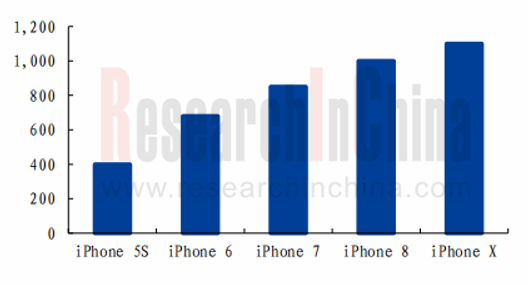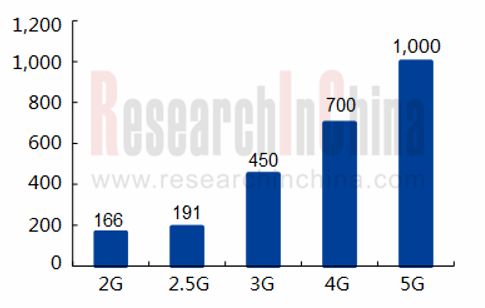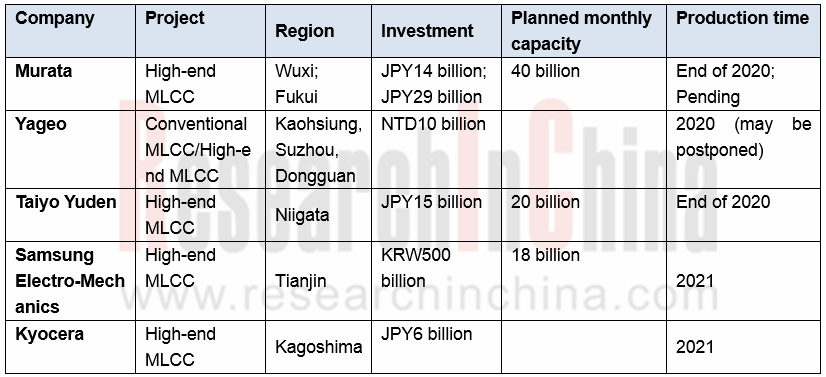As one of the most widely used passive components, MLCC commands approximately 40% of the capacitor market. MLCC finds broad application in fields like communication, consumer electronics, automobile and military, where the robust demand conduces to the expanding MLCC market.
A staggering 64% or so of MLCCs are consumed by consumer electronics, especially smartphones which occupy 39% of total consumption. In iPhone’s case, smartphones with higher configuration use more MLCCs, e.g., an iPhone X needs as many as 1,100 MLCCs compared with an iPhone 5S using 400 pieces. Besides, the portable and intelligent wearables such as TWS headphones and smart watches have drawn much attention from the market over recent years, producing significant demand for MLCCs.

As commercial use of 5G is at a gallop, 5G-enabled smartphones will pack more MLCCs than 4G ones. Examples include a Sub-6Ghz 5G smartphone that uses 10%-15% more MLCCs and an mmWave 5G phone adding 20%-30%. Meanwhile, 5G smartphones’ higher power consumption further drives up demand for high-end, micro/ultra-micro (0201, 01005, etc.) MLCCs with large capacity and low power consumption.

During the faster construction of 5G in 2020, a larger number of 5G base stations to be built and more MLCCs per such a station compared with 4G ones are two factors behind the rising demand for MLCCs. By 2023, global communication base stations’ demand for MLCCs will be 2.1-fold of that in 2019, estimated by Taiyo Yuden. In the meantime, internet of things (IoT) that requires far more stable connectivity will be a beneficiary of low-latency 5G network. A study of VENKEL shows that a terminal needs over 75 MLCCs on average, from which it can be foreseen that more and more connected IOT devices will, beyond doubt, spur the MLCC market to grow.
The development of new energy vehicle and ADAS drives MLCC into a new blue ocean. A common car needs around 3,000 or 4,000 MLCCs while a hybrid/plug-in hybrid vehicle bears around 12,000 pieces and a battery electric vehicle carries virtually 18,000 pieces.
Among vehicle electronic systems, ADAS which applies more MLCCs could collect, detect, recognize and track changed data inside and outside of the vehicle in the shortest time via sensors on the vehicle and helps the driver beware of potential dangers to operate correctly and safely by combining navigation map data to calculate and analyze. Wider coverage of 5G network will be another solution to latency problem. As more and more vehicles carry ADAS that tends to be more intelligent, the demand for MLCCs will multiply.
New energy vehicle with a larger number of control modules like ECU need more passive components to support electronic systems, with a new energy vehicle in want of at least 10,000 MLCCs. With the roll-out of timetables for elimination of ICE vehicles across the world in recent years, new energy vehicles have boasted higher penetration, coupled with more use of MLCCs by a single vehicle, together stimulating the demand for automotive MLCCs.
Of a wide range of automotive MLCC models, those with size ranging from 0402 to 2220 are in use while 0603, 0805 and 1206 get most utilized. Despite unconcern about size of MLCCs, automotive market has a high demanding on them in safety parameters (reliability, service life and failure rate) as well as working temperature, humidity, climate and vibration resistance. Automotive market poses a high entry barrier to MLCC which must be subject to a set of automotive standards (AEC-Q200) and pass quality certification.
It is in the MLCC market that leading players include Murata, Samsung Electro-Mechanics, Yageo, Walsin Technology, Taiyo Yuden, TDK, Kyocera and Chinese Mainland companies like Fenghua Advanced Technology and Chaozhou Three-circle. Since 2016, few MLCC vendors like Murata and TDK have shifted to focus on automotive MLCC, a promising and lucrative high-tech market. This move disrupts the global passive components supply chain and makes low- and mid-end customers turn to companies like Yageo, Fenghua Advanced Technology and Chaozhou Three-circle.
Some vendors have pivoted to the automotive MLCC market.

Murata is the MLCC vendor with the highest market share in the world (approximately 56% of the automotive MLCC market), boasting annual capacity up to 1,100 billion MLCCs or so. In recent years, the company has slashed the capacity of low-end MLCCs while ramping up production of automotive and other high-end products. Murata quickens the R&D and mass production of MLCCs for high-end consumer electronics whilst expediting to launch automotive products. In 2019, Murata began to spawn 008004, which will be used in 5G flagship phones of Apple and Huawei. In April 2020, Murata started mass-production of two new multilayer ceramic capacitors for automotive use -- the NFM15HC105D0G3, which is the world's smallest 0402 size (1.0×0.5mm) three-terminal low-ESL multilayer ceramic capacitor, and the NFM18HC106D0G3, which is the three-terminal low-ESL multilayer ceramic capacitor with the world's highest capacitance of 10μF in 0603 size (1.6×0.8mm), suitable for ADAS and autonomous driving.
The second-ranked Samsung Electro-Mechanics by MLCC market share in the world (ranking fourth in the automotive MLCC market with about 6% share) has followed suit over the recent years, like squeezing out low-end capacity and stepping up the deployment of high-end products. In July 2020, the company developed five new types of MLCCs, including three types for power systems and two types for anti-lock braking systems, which will be available to global automakers in future. Besides building a dedicated automotive production line at the Busan plant, Samsung Electro-Mechanics is pressing ahead with construction of a new plant in Tianjin, China.
Given its inferiority in MLCCs for consumer electronics, TDK cancelled orders for 700 million MLCCs covering about 360 models, and committed itself to mid-to-high-end products in 2017 as the first one aggressively exploring the automotive MLCC market, where TDK now seizes about 25% shares.
MLCC vendors in Mainland China have been developing by leaps and bounds in recent years, especially Fenghua Advanced Technology is one of few Chinese MLCC vendors offering a full range of MLCCs covering 01005-2220 and above sizes with advantages in production scale and technical processes; but it still targets consumer electronics. In 2018, the company launched products in line with the AEC-Q200 standard, but still posing no threat to Japanese and Korean peers due to its weak foundation.
Since 2018, traditional automakers worldwide have begun to deploy electric vehicle manufacturing on a large scale, and the governments have introduced timetables for elimination of ICE vehicle. As the number of MLCCs used in an electric vehicle is 6 times that in an ordinary car, MLCCs are bound to be much sought after. Hundreds of carmakers require automotive MLCCs which are only offered by a few automotive MLCC vendors, inevitably leading to the tight supply of automotive MLCCs in the next two years or three, and a big challenge to any automaker who is in readiness for capacity expansion of electric vehicles and even a mission impossible for emerging automakers because leading MLCC suppliers will give priority to key automakers. The MLCCs from tier-II suppliers as a last resort may cause quality issues and enormous maintenance costs.
Global and China Multi-layer Ceramic Capacitor (MLCC) Industry Report, 2020-2026 highlights the following:
 MLCC industry (definition, classification, industry chain, technology trend, etc.);
MLCC industry (definition, classification, industry chain, technology trend, etc.);
 Global and Chinese MLCC markets (size and forecast, competitive landscape, market segments, etc.);
Global and Chinese MLCC markets (size and forecast, competitive landscape, market segments, etc.);
 Automotive MLCC market (size and forecast, competition pattern, etc.);
Automotive MLCC market (size and forecast, competition pattern, etc.);
 Leading automotive MLCC vendors in China and beyond (profile, operation, business, new products, etc.);
Leading automotive MLCC vendors in China and beyond (profile, operation, business, new products, etc.);
 Upstream MLCC formula vendors (profile, operation, business, new products, etc.)
Upstream MLCC formula vendors (profile, operation, business, new products, etc.)
Autonomous Driving Domain Controller and Central Computing Unit (CCU) Industry Report, 2025
Research on Autonomous Driving Domain Controllers: Monthly Penetration Rate Exceeded 30% for the First Time, and 700T+ Ultrahigh-compute Domain Controller Products Are Rapidly Installed in Vehicles
L...
China Automotive Lighting and Ambient Lighting System Research Report, 2025
Automotive Lighting System Research: In 2025H1, Autonomous Driving System (ADS) Marker Lamps Saw an 11-Fold Year-on-Year Growth and the Installation Rate of Automotive LED Lighting Approached 90...
Ecological Domain and Automotive Hardware Expansion Research Report, 2025
ResearchInChina has released the Ecological Domain and Automotive Hardware Expansion Research Report, 2025, which delves into the application of various automotive extended hardware, supplier ecologic...
Automotive Seating Innovation Technology Trend Research Report, 2025
Automotive Seating Research: With Popularization of Comfort Functions, How to Properly "Stack Functions" for Seating?
This report studies the status quo of seating technologies and functions in aspe...
Research Report on Chinese Suppliers’ Overseas Layout of Intelligent Driving, 2025
Research on Overseas Layout of Intelligent Driving: There Are Multiple Challenges in Overseas Layout, and Light-Asset Cooperation with Foreign Suppliers Emerges as the Optimal Solution at Present
20...
High-Voltage Power Supply in New Energy Vehicle (BMS, BDU, Relay, Integrated Battery Box) Research Report, 2025
The high-voltage power supply system is a core component of new energy vehicles. The battery pack serves as the central energy source, with the capacity of power battery affecting the vehicle's range,...
Automotive Radio Frequency System-on-Chip (RF SoC) and Module Research Report, 2025
Automotive RF SoC Research: The Pace of Introducing "Nerve Endings" such as UWB, NTN Satellite Communication, NearLink, and WIFI into Intelligent Vehicles Quickens
RF SoC (Radio Frequency Syst...
Automotive Power Management ICs and Signal Chain Chips Industry Research Report, 2025
Analog chips are used to process continuous analog signals from the natural world, such as light, sound, electricity/magnetism, position/speed/acceleration, and temperature. They are mainly composed o...
Global and China Electronic Rearview Mirror Industry Report, 2025
Based on the installation location, electronic rearview mirrors can be divided into electronic interior rearview mirrors (i.e., streaming media rearview mirrors) and electronic exterior rearview mirro...
Intelligent Cockpit Tier 1 Supplier Research Report, 2025 (Chinese Companies)
Intelligent Cockpit Tier1 Suppliers Research: Emerging AI Cockpit Products Fuel Layout of Full-Scenario Cockpit Ecosystem
This report mainly analyzes the current layout, innovative products, and deve...
Next-generation Central and Zonal Communication Network Topology and Chip Industry Research Report, 2025
The automotive E/E architecture is evolving towards a "central computing + zonal control" architecture, where the central computing platform is responsible for high-computing-power tasks, and zonal co...
Vehicle-road-cloud Integration and C-V2X Industry Research Report, 2025
Vehicle-side C-V2X Application Scenarios: Transition from R16 to R17, Providing a Communication Base for High-level Autonomous Driving, with the C-V2X On-board Explosion Period Approaching
In 2024, t...
Intelligent Cockpit Patent Analysis Report, 2025
Patent Trend: Three Major Directions of Intelligent Cockpits in 2025
This report explores the development trends of cutting-edge intelligent cockpits from the perspective of patents. The research sco...
Smart Car Information Security (Cybersecurity and Data Security) Research Report, 2025
Research on Automotive Information Security: AI Fusion Intelligent Protection and Ecological Collaboration Ensure Cybersecurity and Data Security
At present, what are the security risks faced by inte...
New Energy Vehicle 800-1000V High-Voltage Architecture and Supply Chain Research Report, 2025
Research on 800-1000V Architecture: to be installed in over 7 million vehicles in 2030, marking the arrival of the era of full-domain high voltage and megawatt supercharging.
In 2025, the 800-1000V h...
Foreign Tier 1 ADAS Suppliers Industry Research Report 2025
Research on Overseas Tier 1 ADAS Suppliers: Three Paths for Foreign Enterprises to Transfer to NOA
Foreign Tier 1 ADAS suppliers are obviously lagging behind in the field of NOA.
In 2024, Aptiv (2.6...
VLA Large Model Applications in Automotive and Robotics Research Report, 2025
ResearchInChina releases "VLA Large Model Applications in Automotive and Robotics Research Report, 2025": The report summarizes and analyzes the technical origin, development stages, application cases...
OEMs’ Next-generation In-vehicle Infotainment (IVI) System Trends Report, 2025
ResearchInChina releases the "OEMs’ Next-generation In-vehicle Infotainment (IVI) System Trends Report, 2025", which sorts out iterative development context of mainstream automakers in terms of infota...